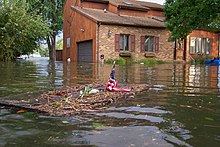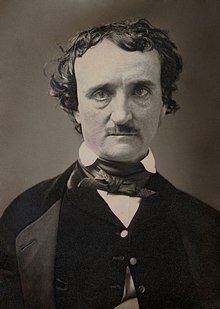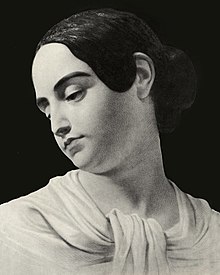Portal:Maryland/Featured article
This subpage shows all excerpts which it may display in the main portal. When transcluded, it shows one random excerpt with a list of articles. Only FA-class articles should be added.
In Maryland and Washington, D.C., the effects of Hurricane Isabel were among the most damaging from a tropical cyclone in the respective metropolitan area. Hurricane Isabel formed from a tropical wave on September 6, 2003, in the tropical Atlantic Ocean. It moved northwestward, and within an environment of light wind shear and warm waters, it steadily strengthened to reach peak winds of 165 miles per hour (266 km/h) on September 11. After fluctuating in intensity for four days, Isabel gradually weakened and made landfall on the Outer Banks of North Carolina with winds of 105 miles per hour (169 km/h) on September 18. It quickly weakened over land and became extratropical over western Pennsylvania the next day.
On September 19, Tropical Storm Isabel passed through extreme western Maryland, though its large circulation produced tropical storm force winds throughout the state. About 1.24 million people lost power throughout the state. The worst of its effects came from its storm surge, which inundated areas along the coast and resulted in severe beach erosion. On the Eastern Shore, hundreds of buildings were damaged or destroyed, primarily in Queen Anne's County from tidal flooding. Thousands of houses were affected in Central Maryland, with severe storm surge flooding reported in Baltimore and Annapolis. Washington, D.C., sustained moderate damage, primarily from the winds. Throughout Maryland and Washington, damage totaled about $820 million (equivalent to $1.36 billion in 2023), with only one fatality due to flooding. (Full article...)
The 2008 Humanitarian Bowl was a postseason college football bowl game between the Maryland Terrapins and the Nevada Wolf Pack on December 30, 2008. It was the two teams' first meeting. The game featured two conference tie-ins: the University of Maryland represented the Atlantic Coast Conference (ACC) and the University of Nevada represented the Western Athletic Conference (WAC). The game was played at Bronco Stadium in Boise, Idaho and was the 12th edition of the Humanitarian Bowl. It was sponsored by the New Plymouth, Idaho-based company Roady's Truck Stops, which claims to be the largest chain of truck stops in the United States. The featured match-up was between what was called a "wildly inconsistent" Maryland team and the third-best rushing defense and fifth-best total offense of Nevada. The result was an offensive shoot-out. The final score of 42–35 in favor of Maryland exceeded total-points predictions by as much as 17 and tied the all-time Humanitarian Bowl record. (Full article...)
George Herman "Babe" Ruth (February 6, 1895 – August 16, 1948) was an American professional baseball player whose career in Major League Baseball (MLB) spanned 22 seasons, from 1914 through 1935. Nicknamed "the Bambino" and "the Sultan of Swat", he began his MLB career as a star left-handed pitcher for the Boston Red Sox, but achieved his greatest fame as a slugging outfielder for the New York Yankees. Ruth is regarded as one of the greatest sports heroes in American culture and is considered by many to be the greatest baseball player of all time. In 1936, Ruth was elected to the Baseball Hall of Fame as one of its "first five" inaugural members.
At age seven, Ruth was sent to St. Mary's Industrial School for Boys, a reformatory where he was mentored by Brother Matthias Boutlier of the Xaverian Brothers, the school's disciplinarian and a capable baseball player. In 1914, Ruth was signed to play Minor League baseball for the Baltimore Orioles but was soon sold to the Red Sox. By 1916, he had built a reputation as an outstanding pitcher who sometimes hit long home runs, a feat unusual for any player in the dead-ball era. Although Ruth twice won 23 games in a season as a pitcher and was a member of three World Series championship teams with the Red Sox, he wanted to play every day and was allowed to convert to an outfielder. With regular playing time, he broke the MLB single-season home run record in 1919 with 29. (Full article...)
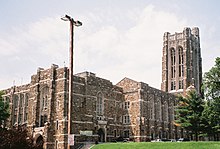
Baltimore City College, known colloquially as City, City College, and B.C.C., is a college preparatory school with a liberal arts focus and selective admissions criteria located in Baltimore, Maryland. Opened in October 1839, B.C.C. is the third-oldest active public high school in the United States. City College is a public exam school and an International Baccalaureate World School at which students in the ninth and tenth grades participate in the IB Middle Years Programme while students in the eleventh and twelfth grades participate in the IB Diploma Programme.
The school is situated on a 38 acres (0.15 km2) hilltop campus located in the Coldstream-Homestead-Montebello neighborhood in Northeast Baltimore. The main campus building, a designated National Historic Landmark, is constructed of granite and limestone in a Collegiate Gothic architectural style and features a 200-foot-tall Gothic tower. (Full article...)
The Baltimore railroad strike of 1877 involved several days of work stoppage and violence in Baltimore, Maryland, in 1877. It formed a part of the Great Railroad Strike of 1877, during which widespread civil unrest spread nationwide following the global depression and economic downturns of the mid-1870s. Strikes broke out along the Baltimore and Ohio Railroad (B&O) on July 16, the same day that 10% wage reductions were scheduled. Violence erupted in Baltimore on July 20, with police and soldiers of the Maryland National Guard clashing with crowds of thousands gathered throughout the city. In response, President Rutherford B. Hayes ordered federal troops to Baltimore, local officials recruited 500 additional police, and two new national guard regiments were formed. Peace was restored on July 22. Between 10 and 22 were killed, more than 150 were injured, and many more were arrested. (Full article...)

The Baltimore Steam Packet Company, nicknamed the Old Bay Line, was an American steamship line from 1840 to 1962 that provided overnight steamboat service on Chesapeake Bay, primarily between Baltimore, Maryland, and Norfolk, Virginia. Called a "packet" for the mail packets carried on government mail contracts, the term in the 19th century came to mean a steamer line operating on a regular, fixed daily schedule between two or more cities. When it closed in 1962 after 122 years of existence, it was the last surviving overnight steamship passenger service in the United States.
In addition to regularly calling on Baltimore and Norfolk, the Baltimore Steam Packet Company at various times provided freight, passenger and vehicle transport to Washington, D.C., Old Point Comfort, and Richmond, Virginia. The Old Bay Line, as it came to be known by the 1860s, was acclaimed for its genteel service and fine dining, serving Chesapeake Bay specialties. Walter Lord, famed author of A Night to Remember (and whose grandfather had been the packet line's president from 1893 to 1899), mused that its reputation for excellent service was attributable to "some magical blending of the best in the North and the South, made possible by the Company's unique role in 'bridging' the two sections ... the North contributed its tradition of mechanical proficiency, making the ships so reliable; while the South contributed its gracious ease". (Full article...)
Ruth Elizabeth "Bazy" Tankersley (née McCormick, formerly Miller; March 7, 1921 – February 5, 2013) was an American breeder of Arabian horses and a newspaper publisher. She was a daughter of U.S. Senator Joseph Medill McCormick. Her mother was progressive Republican U.S. Representative Ruth Hanna McCormick, making Tankersley a granddaughter of Senator Mark Hanna of Ohio. Although Tankersley was involved with conservative Republican causes as a young woman, including a friendship with Senator Joseph McCarthy, her progressive roots reemerged in later years. By the 21st century, she had become a strong supporter of environmental causes and backed Barack Obama for president in 2008. Tankersley's father died when she was a child. When her mother remarried, the family moved to the southwestern United States, where Tankersley spent considerable time riding horses. She became particularly enamored of the Arabian breed after she was given a part-Arabian to ride. At the age of 18, she began working as a reporter for a newspaper published by her mother. She later ran a newspaper in Illinois with her first husband, Peter Miller. In 1949, she became the publisher of the conservative Washington Times-Herald. That paper was owned by her uncle, the childless Robert McCormick, who viewed Tankersley as his heir until the two had a falling out over editorial control of the newspaper and her relationship with Garvin Tankersley, who became her second husband. After The Washington Post absorbed the Times-Herald, she shifted to full-time horse breeding. (Full article...)
Charles Carroll (1661 – 1720), sometimes called Charles Carroll the Settler to differentiate him from his son and grandson, was an Irish-born planter and lawyer who spent most of his life in the English Province of Maryland. Carroll, a Catholic, is best known for his efforts to hold office in the Protestant-dominated colony which eventually resulted in the disfranchisement of Maryland's Catholics. The second son of Irish Catholic parents, Carroll was educated in France as a lawyer before returning to England, where he pursued the first steps in a legal career. Before that career developed, he secured a position as Attorney General of the young colony of Maryland. Its founder George Calvert, 1st Baron Baltimore and his descendants intended it as a refuge for persecuted Catholics.
Carroll supported Charles Calvert, 3rd Baron Baltimore, the colony's Catholic proprietor, in an unsuccessful effort to prevent the Protestant majority from gaining political control over Maryland. Following the overthrow of the Calvert proprietorship and the subsequent exclusion of Catholics from colonial government, Carroll turned his attention to owning slave plantations, law, business, and various offices in the proprietor's remnant organization. He was the wealthiest man in the colony by the time of his death. In the last years of his life, Carroll attempted to regain some vestige of political power for Catholics in the colony, but the Protestant colonial assembly and Governor John Hart disfranchised them. His son, Charles Carroll of Annapolis, became a wealthy planter and his grandson, Charles Carroll of Carrollton, also wealthy, was the only Catholic signer of the United States Declaration of Independence. (Full article...)
Edgar Allan Poe (né Edgar Poe; January 19, 1809 – October 7, 1849) was an American writer, poet, author, editor, and literary critic who is best known for his poetry and short stories, particularly his tales of mystery and the macabre. He is widely regarded as a central figure of Romanticism and Gothic fiction in the United States, and of American literature. Poe was one of the country's earliest practitioners of the short story, and is considered the inventor of the detective fiction genre, as well as a significant contributor to the emerging genre of science fiction. He is the first well-known American writer to earn a living through writing alone, resulting in a financially difficult life and career.
Poe was born in Boston, the second child of actors David and Elizabeth "Eliza" Poe. His father abandoned the family in 1810, and when his mother died the following year, Poe was taken in by John and Frances Allan of Richmond, Virginia. They never formally adopted him, but he was with them well into young adulthood. He attended the University of Virginia but left after a year due to lack of money. He quarreled with John Allan over the funds for his education, and his gambling debts. In 1827, having enlisted in the United States Army under an assumed name, he published his first collection, Tamerlane and Other Poems, credited only to "a Bostonian". Poe and Allan reached a temporary rapprochement after the death of Allan's wife in 1829. Poe later failed as an officer cadet at West Point, declared a firm wish to be a poet and writer, and parted ways with Allan. (Full article...)
George Calvert, 1st Baron Baltimore (/ˈbɔːltɪmɔːr/; 1580 – 15 April 1632) was an English peer and politician. He achieved domestic political success as a member of parliament and later Secretary of State under King James I. He lost much of his political power after his support for a failed marriage alliance between Prince Charles and the Spanish House of Habsburg royal family. Rather than continue in politics, he resigned all of his political offices in 1625 except for his position on the Privy Council and declared his Catholicism publicly. He was created Baron Baltimore in the Peerage of Ireland upon his resignation. Baltimore Manor was located in County Longford, Ireland.
Calvert took an interest in the British colonization of the Americas, at first for commercial reasons and later to create a refuge for persecuted Irish and English Catholics. He became the proprietor of Avalon, the first sustained English settlement on the southeastern peninsula on the island of Newfoundland (off the eastern coast of modern Canada). Discouraged by its cold and sometimes inhospitable climate and the sufferings of the settlers, he looked for a more suitable spot further south and sought a new royal charter to settle the region, which would become the state of Maryland. Calvert died five weeks before the new Charter was sealed, leaving the settlement of the Maryland colony to his son Cecil (1605–1675). His second son Leonard Calvert (1606–1647) was the first colonial governor of the Province of Maryland. (Full article...)
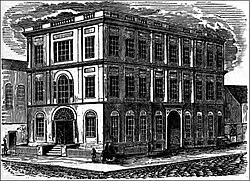
The history of The Baltimore City College began in March 1839, when the City Council of Baltimore, Maryland, passed a resolution mandating the creation of a male high school with a focus on the study of English and classical literature. "The High School" (later becoming The Baltimore City College) was opened later in the same year on October 20, with 46 pupils under the direction of Professor Nathan C. Brooks,(1809-1898), a local noted classical educator and poet, who became the first principal of a new type of higher institution in the developing public education system in the city begun in 1829. It is now considered to be the third oldest public high school / secondary school in the nation. In 1850, the Baltimore City Council granted the school, then known as the "Central High School of Baltimore", the authority to present its graduates with certificates of completion. An effort to expand that academic power and allow the then named "Central High School of Baltimore" to confer Bachelor of Arts degrees began following the Civil War in 1865, and continued the following year with the renaming of the institution as "The Baltimore City College", which it still holds to this day, with also the retitling of its chief academic officer from "principal" to "president", along with an increase in the number of years of its course of study and the expansion of its courses. However, despite this early elevation effort, it ended at that brief period unsuccessfully in 1869, although the B.C.C. continued for a number of years as a hybrid public high school and early form of junior college (later known as community college) which did not fully appear in America in different form until the beginning of the 20th century. Very often the elaborate decorative fancy engraved graduation diploma from the B.C.C. in the late 19th and early 20th centuries was accepted by many other colleges and universities entitling City graduates to enter upper-division schools at the sophomore year, (which was also coincidentally a privilege also accorded to its later local academic and athletic rival for 127 years - "Poly", the Baltimore Polytechnic Institute, founded 1883 as the Baltimore Manual Training School, later renamed 1893).
As the importance of higher education increased in the early 20th century, the High School's priorities shifted to preparing students for college. In 1927, only one year before the school moved from its home at Howard and Centre Streets for 53 years to the magnificent stone "Castle on the Hill" on "Collegian Hill", the academic program was further changed, when the City College divided its curriculum into two tracks: the standard college preparatory program, or "'B' Course", and a more rigorous stiff "Advanced College Prep" curriculum, the famed "'A' Course" of study focusing on humanities, social studies, liberal arts and the Classics. (also available in the mathematics/science/technology fields in a more structured form with little options/electives at "Poly" and at Western and Eastern High Schools for girls). (Full article...)
There are 23 counties and one independent city in the U.S. state of Maryland. Though formally an independent city rather than a county, the City of Baltimore is considered the equal of a county for most purposes and is functionally a county-equivalent in most respects. Many of the counties in Maryland were named for relatives of the Barons Baltimore, who were the proprietors of the Maryland colony from its founding in 1634 through 1771. The Barons Baltimore were Catholic, and George Calvert, 1st Baron Baltimore, originally intended that the colony be a haven for English Catholics, though for most of its history Maryland has had a majority of Protestants. (Full article...)
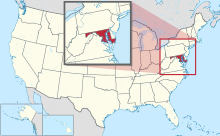
The Maryland House of Delegates is the lower house of the Maryland General Assembly, the state legislature of the U.S. State of Maryland. Three delegates are elected from each district, though some districts are divided into sub-districts. In the original state constitution, four delegates were elected from each county to one-year terms, and two were elected from each of the major early cities of Baltimore and Annapolis. Reforms in the 1830s, however, led to the apportionment of delegates by population rather than geography, and by 1922, delegates served four year terms. The modern system of apportionment of seats began in 1972, when 47 districts of roughly equal population were identified, although sub-districts were created to ensure local representation for areas with too little population to warrant an entire district.
Delegates are elected in even years when the President of the United States is not being elected, similar to most other state offices in Maryland. The most recent election was in November 2022. Delegates are not term-limited. (Full article...)

The Maryland Tercentenary half dollar was a commemorative fifty-cent piece issued by the United States Bureau of the Mint in 1934. It depicts Cecil Calvert, 2nd Baron Baltimore on the obverse and the Coat of Arms of Maryland on the reverse.
The Maryland Tercentenary Commission sought a coin in honor of the 300th anniversary of the arrival of English settlers in Maryland. The state's two senators introduced legislation for such a piece, and it passed both houses of Congress with no opposition. A design had already been prepared by Professor Hans Schuler; it passed review by the Commission of Fine Arts, though there was controversy then and since over whether Lord Baltimore, a Cavalier and Catholic, would have worn a collar typical of Puritans. (Full article...)
Nicholas James Adenhart (August 24, 1986 – April 9, 2009) was an American right-handed baseball starting pitcher who played parts of two seasons in Major League Baseball (MLB) for the Los Angeles Angels of Anaheim. In just four career games, Adenhart pitched 18 innings and posted a win–loss record of 1–0.
A graduate of Williamsport High School, Adenhart was highly touted as a high school prospect until an injury in his final game required Tommy John surgery. He was drafted by the Angels in the 14th round of the 2004 Major League Baseball draft, and began playing in their minor league system after the surgery was a success. He spent three full seasons in the minor leagues before making his major league debut on May 1, 2008. After appearing in three games, Adenhart spent the rest of 2008 in the minor leagues developing his skills, and in 2009 he earned a spot in the Angels' starting rotation. (Full article...)
The Royal Blue was the Baltimore and Ohio Railroad (B&O)'s flagship passenger train between New York City and Washington, D.C., in the United States, beginning in 1890. The Baltimore-based B&O also used the name between 1890 and 1917 for its improved passenger service between New York and Washington, collectively dubbed the Royal Blue Line. Using variants such as the Royal Limited and Royal Special for individual Royal Blue trains, the B&O operated the service in partnership with the Reading Railroad and the Central Railroad of New Jersey. Principal intermediate cities served were Philadelphia, Wilmington, and Baltimore. Later, as Europe reeled from the carnage of World War I and connotations of European royalty fell into disfavor, the B&O discreetly omitted the sobriquet Royal Blue Line from its New York passenger service and the Royal Blue disappeared from B&O timetables. Beginning in 1917, former Royal Blue Line trains were renamed: the Royal Limited (inaugurated on May 15, 1898), for example, became the National Limited, continuing west from Washington to St. Louis via Cincinnati. During the Depression, the B&O hearkened back to the halcyon pre-World War I era when it launched a re-christened Royal Blue train between New York and Washington in 1935. The B&O finally discontinued all passenger service north of Baltimore on April 26, 1958, including the Royal Blue.
Railroad historian Herbert Harwood said, in his seminal history of the service, "First conceived in late Victorian times to promote a new railroad line ... it was indeed one of the most memorable images in the transportation business, an inspired blend of majesty and mystique ... Royal Blue Line ... Royal Blue Trains ... the Royal Blue all meant different things at different times. But essentially they all symbolized one thing: the B&O's regal route." Between the 1890s and World War I, the B&O's six daily Royal Blue trains providing service between New York and Washington were noted for their luxury, elegant appearance, and speed. The car interiors were paneled in mahogany, had fully enclosed vestibules (instead of open platforms, still widely in use at the time on U.S. railroads), then-modern heating and lighting, and leaded glass windows. The car exteriors were painted a deep "Royal Saxony blue" color with gold leaf trim, a color personally chosen by the B&O's tenth president, Charles F. Mayer. (Full article...)
Spiro Theodore Agnew (/ˈspɪəroʊ ˈæɡnjuː/; November 9, 1918 – September 17, 1996) was the 39th vice president of the United States, serving from 1969 until his resignation in 1973. He is the second of two vice presidents to resign the position, the first being John C. Calhoun in 1832.
Agnew was born in Baltimore to a Greek immigrant father and an American mother. He attended Johns Hopkins University and graduated from the University of Baltimore School of Law. He was a campaign aide for U.S. Representative James Devereux in the 1950s, and was appointed to the Baltimore County Board of Zoning Appeals in 1957. In 1962, he was elected Baltimore county executive. In 1966, Agnew was elected governor of Maryland, defeating his Democratic opponent George P. Mahoney and independent candidate Hyman A. Pressman. (Full article...)

The Wire is an American crime drama television series created and primarily written by American author and former police reporter David Simon. The series was broadcast by the cable network HBO in the United States. The Wire premiered on June 2, 2002, and ended on March 9, 2008, comprising 60 episodes over five seasons. The idea for the show started out as a police drama loosely based on the experiences of Simon's writing partner Ed Burns, a former homicide detective and public school teacher.
Set and produced in Baltimore, Maryland, The Wire introduces a different institution of the city and its relationship to law enforcement in each season while retaining characters and advancing storylines from previous seasons. The five subjects are, in chronological order; the illegal drug trade, the port system, the city government and bureaucracy, education and schools, and the print news medium. Simon chose to set the show in Baltimore because of his familiarity with the city. (Full article...)

Thomas F. Mulledy SJ (/mʌˈleɪdi/ muh-LAY-dee; August 12, 1794 – July 20, 1860) was an American Catholic priest and Jesuit who became the president of Georgetown College, a founder of the College of the Holy Cross, and a Jesuit provincial superior. His brother, Samuel Mulledy, also became a Jesuit and president of Georgetown.
Mulledy entered the Society of Jesus and was educated for the priesthood in Rome, before completing his education in the United States. He twice served as president of Georgetown College in Washington, D.C. At Georgetown, Mulledy undertook a significant building campaign, which resulted in Gervase Hall and Mulledy Hall (later renamed Isaac Hawkins Hall). He became the second provincial superior of the Maryland Province of the Jesuit order, and orchestrated the sale of the province's slaves in 1838 to settle its debts. This resulted in outcry from his fellow Jesuits and censure by the church authorities in Rome, who exiled him to Nice in the Kingdom of Piedmont-Sardinia for several years. While provincial superior, Mulledy was also the vicar general for the Diocese of Boston. (Full article...)
Virginia Eliza Poe (née Clemm; August 15, 1822 – January 30, 1847) was the wife of American writer Edgar Allan Poe. The couple were first cousins and publicly married when Virginia Clemm was 13 and Poe was 27. Biographers disagree as to the nature of the couple's relationship. Though their marriage was loving, some biographers suggest they viewed one another more like a brother and sister. In January 1842, she contracted tuberculosis, growing worse for five years until she died of the disease at the age of 24 in the family's cottage, at that time outside New York City.
Along with other family members, Virginia Clemm and Edgar Allan Poe lived together off and on for several years before their marriage. The couple often moved to accommodate Poe's employment, living intermittently in Baltimore, Philadelphia, and New York. A few years after their wedding, Poe was involved in a substantial scandal involving Frances Sargent Osgood and Elizabeth F. Ellet. Rumors about amorous improprieties on her husband's part affected Virginia Poe so much that on her deathbed she claimed that Ellet had murdered her. After her death, her body was eventually placed under the same memorial marker as her husband's in Westminster Hall and Burying Ground in Baltimore, Maryland. Only one image of Virginia Eliza Clemm Poe has been authenticated: a watercolor portrait painted several hours after her death. (Full article...)
William Matthews (December 16, 1770 – April 30, 1854), occasionally spelled Mathews, was an American who became the fifth Roman Catholic priest ordained in the United States and the first such person born in British America. Born in the colonial Province of Maryland, he was briefly a novice in the Society of Jesus. After being ordained, he became influential in establishing Catholic parochial and educational institutions in Washington, D.C. He was the second pastor of St. Patrick's Church, serving for most of his life. He served as the sixth president of Georgetown College, later known as Georgetown University. Matthews acted as president of the Washington Catholic Seminary, which became Gonzaga College High School, and oversaw the continuity of the school during suppression by the church and financial insecurity. Matthews was vicar apostolic and apostolic administrator of the Diocese of Philadelphia during a period of ecclesiastical turmoil. He was a co-founder and president of the Washington Library Company for thirteen years—the first public library in the District of Columbia. He also was co-director and trustee of the District of Columbia Public Schools, where he was one of the superintendents of a school. He played a significant role in the founding of Washington Visitation Academy for girls, St. Peter's Church on Capitol Hill, and the parish that now includes the Cathedral of St. Matthew the Apostle. (Full article...)

William McSherry SJ (July 19, 1799 – December 18, 1839) was an American Catholic priest and Jesuit who became the president of Georgetown College and a Jesuit provincial superior. The son of Irish immigrants, McSherry was educated at Georgetown College, where he entered the Society of Jesus. As one of the first Americans to complete the traditional Jesuit course of training, he was sent to Rome to be educated for the priesthood. There, he made several discoveries of significant, forgotten holdings in the Jesuit archives, which improved historians' knowledge of the early European settling of Maryland and of the language of Indian tribes there.
McSherry became the first provincial superior of the Jesuits' Maryland Province from 1833 to 1837, and laid the groundwork for the sale of the province's slaves in 1838. He then briefly became the president of Georgetown College in 1837, and was simultaneously made provincial superior for a second time in 1839, despite suffering illness to which he would succumb several months later. (Full article...)

